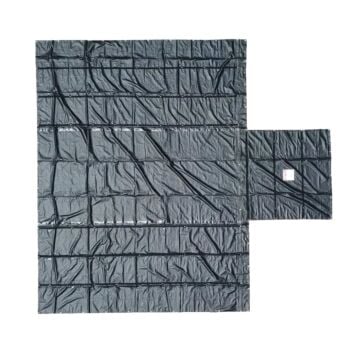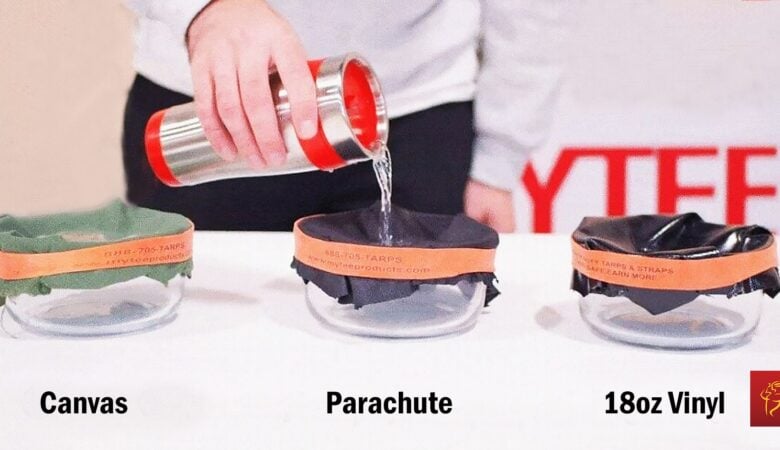Flatbed truck tarps are used to protect cargo from debris, ice, inclement weather and other damaging elements during transport. Flatbed truck tarps usually come in a wide variety of materials, sizes, and even functionality. There is also no one-size-fits-all solution for these products. All these factors can make it extremely challenging for the uninitiated to effectively determine just what kind of tarp is ideal for their exact needs and preferences. To this end, this guide has been specifically explained and briefly elaborates on some of the most common varieties of these items, and what use they are generally put through while tarping a load.
Types of Flatbed Tarps
There are a wide variety of tarps out there that can cover your flatbed trailer load.
Mainly 8 Types of Flatbed Tarps are Popular in the Trucking Industry:
- Lumber Tarps
- Smoke Tarps
- Steel Tarps
- Machinery Tarps
- Coil Tarps
- Parachute/Air Bag Tarps
- Side Kit Tarps
- Bee Hauling Tarps
1. Lumber Tarps
These products are primarily used to protect the lumber from exposure to the elements as well as being in contact with the flatbed truck’s exterior components. Despite this fact, this type of tarp can also be used for safely transporting other kinds of cargo. Lumber tarps come with flaps at their ends that are meant to cover the nether regions of a flatbed truck’s load.

Lumber tarps generally come in the following sizes:
- 16 X 27
- 20 X 27
- 24 X 27
2. Smoke Tarps
This category of flatbed truck tarps is designed to effectually wrap around the front area of the flatbed load. In essence, they are meant to protect cargo from accumulating soot, dirt and more importantly, the truck’s exhaust emissions while it is in transit.
Smoke tarps can also be utilized to prevent the wind from generating the unnerving whistling sound that emanates from transporting cargo such as PVC and steel pipes.

Smoke tarps generally come in the following sizes:
- 12 X 16
- 12 X 20
- 10 X 12
3. Steel Tarps
This variety of tarps features a 4-sided severe steel construction that is totally devoid of flaps. This unique configuration makes steel tarps excellent for transporting:
- Cables
- Steel rod
- Sheet metal
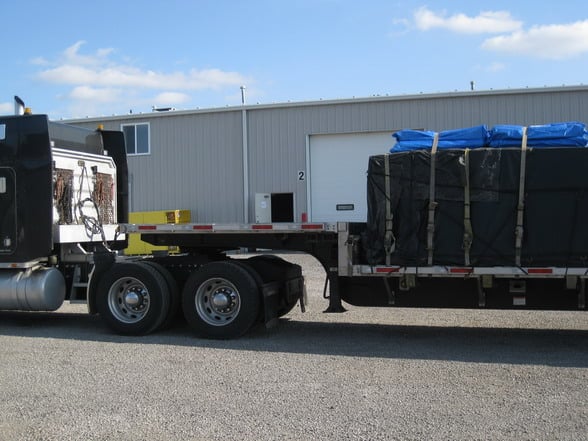
Steel tarps come in the following sizes:
- 16 X 27
- 20 X 27
- 24 X 27
4. Dump Truck Tarps
Dump truck tarps is a waterproof tarp and primarily designed for protecting dump truck loads. However, it can also be used with other similarly styled trucks like:
- Fertilizer Tenders
- Trailers
- Grain Carts
- Grain Trucks
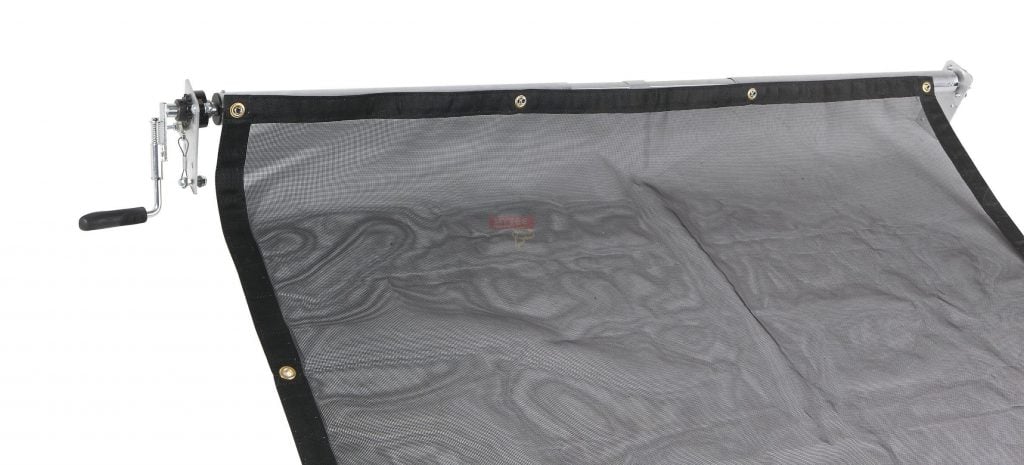
Dump truck tarps dimensions can be:
- 7 X 15
- 7 X 18
- 7 X 21
Continue to Read: 10 Different Types of Tarps
How to Tarp and Secure Flatbed Load?
Illustration images are courtesy of Brian Phillips, from his YouTube channel Driven Trucking. Specifically, these are stills from the video “How to Tarp a Flatbed Load – Flatbed Trucking Basics.”
Step #1
First, place the moving blankets over the sharpest edges or corners of the load. Once it’s placed, strap the blanket and fold it over the back over the sharp steel edges. This gives you twice as many layers of protection from the blanket.

For some loads, corner and edge protectors are a better option than moving blankets. You can even double-up protection by combining blankets and protectors.
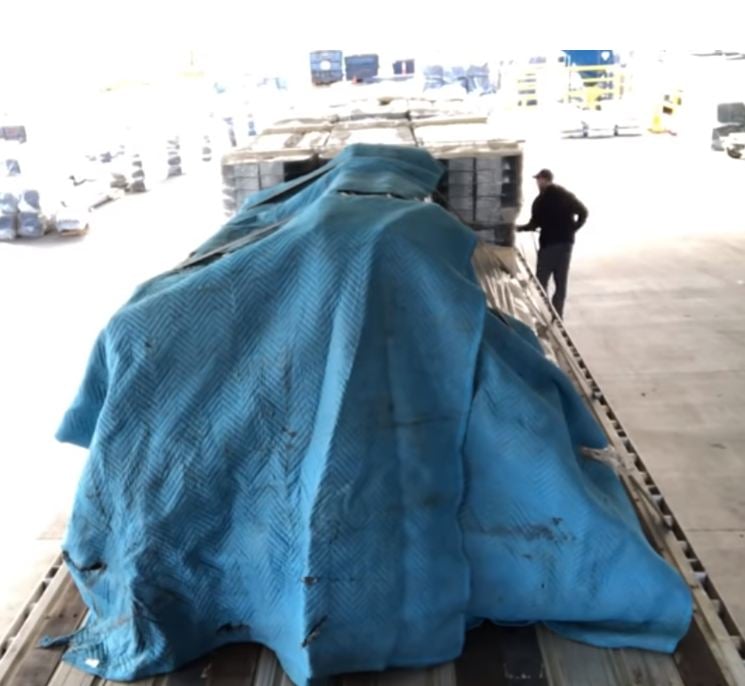
Step #2
Stand level with the truck bed (on a step, secondary platform, or other?), facing the back of the load, and toss rolled/folded tarp on top of the load. This is placing your back tarp.

Step #3
Unfold/unroll the back tarp by moving along the sides of the truck bed and load and unfolding as you go. Continually pull the tarp down to cover the side of the load that you’re facing. Make sure to cover over the moving blankets.
Step #4
Secure the tarp to the trailer itself with bungees or tarp straps. Put the hooks of the bungees through the D-rings, then crimp the hooks inward, so they don’t loosen and the end of the hook doesn’t poke holes in the tarp.

Start with the four corner tie-down points and the tie-down points in the middle (lengthwise) of the tarp. This keeps the tarp in place. Then, secure the tarp across the bottom row of D-rings with enough tension in the bungees to keep the tarp from flapping. You can anchor the bungees on the rub rail or other anchor points.
Step #5
If your tarp doesn’t have a drop flap at the back, you’ll have to improvise a bit at the back of the load.
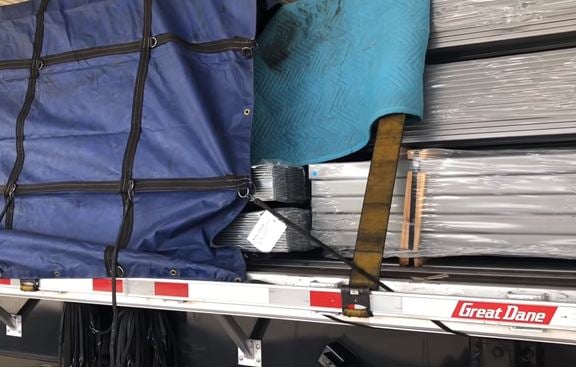
At the back of the load, use a bungee to create a seam that pushes any excess fabric toward the middle of the truck, like a flap. Then, fold both flaps of excess material inward and tie them in place with the bungee straps.

Step #6
Now, place the front tarp. Use a similar method, except this time, stand at the front end of the load, flip the tarp over that front side, and unroll and strap the tarp from there. Where the tarps overlap, tuck the back tarp underneath the front tarp and tie the front tarp down over on top of it.

If the front and back tarps completely cover the load, you’re done!
For very tall or wide/oversized loads, sometimes tarps must be layered vertically in order to cover the entire load. These are the instances where the middle or top row of D-rings can come in handy. Those rows allow you to secure a tarp to a second tarp, using bungees or other tarp tie-downs, to create a longer, larger cover.
Essential Equipment to Use While Tarping a Flatbed Trailer Load
As would be expected there are also a number of flatbed accessories, which are necessary for properly using flatbed truck tarps in any kind of situation. This includes tie-downs that secure these products in place. Let us now take a look at some of the most common of these accessories.
1. Bungee Straps
Also known as Rubber Tarp Straps, these are handy tie-downs that come in two major types, natural rubber, and EPDM rubber. The first variety is designed to be utilized in areas that are characterized by cold climatic conditions. Natural rubber tie-downs cannot crack, tear or get brittle even when exposed to freezing temperatures for protracted periods of time.

On the other hand, EPDM rubber straps are meant for areas that experience hot weather. They can effortlessly withstand prolonged exposure to scorching sunlight.
2. Shock Cords
This is a stretchy rope that comes with a heavy-duty polyester fabric that encases a rubber core. A shock cord can be the best solution if you wish for a custom-length tie-down, which you can make use of by adding a bungee hook.
3. Rubber Ropes
Just like a shock cord, this type of tie-down can be cut to the exact length you desire. Rubber Ropes usually come in two varieties, which are the hollow and solid core. The first type is designed for heavy-duty applications and the second is for lightweight applications.
How to Repair a Vinyl Tarp?
The best way to repair a vinyl flatbed tarp is to use a tarp repair kit.
Our tarp repair kits come with a patch that’s 18” wide by 60” long, or 1 ½ feet by 5 feet. The kits also come with HH-66 vinyl cement, which can be used to bond urethanes, vinyl foams, leather, and metals as well as patch-up tarps. It’s sometimes called a synthetic resin, or solvent.
Steps to Repair a Tarp:
- First cut a round patch that’s large enough to cover the hole, crack, or other section of damage in the tarp. The patch should have a radius that’s at least 1”-2” wider than the hole of a segment of damage.
- Clean the area of the tarp that you’re going to patch over with rubbing alcohol.
- Use the brush applicator to completely cover the patch with the HH-66 Vinyl Cement. Cover the area of the tarp that the patch with cover as well.
- Place the patch cement side down over the damaged part of the tarp. Press the patch flat. You can even use a roller to smooth the patch completely flat.
The seal will be ready in a matter of minutes, but for best results wait about two hours before using the tarp again.
Which Tarp is Right for Your Load?
In order to figure out which tarp is right for your load, you need to take a few things into consideration.
Q 1. First, is your load live cargo, such as beehives or trees for a nursery?
If so, your cargo has special needs. Live cargo needs more temperature control, as well as a means to eat, drink, and breathe (or, in the case of trees, absorb oxygen), in order to stay alive.
Live cargo is also more fragile than most other, heavier-duty kinds of cargo, so it’s important that it isn’t covered by anything too heavy that might damage it.
For these reasons, lightweight mesh tarps and specialty bee-hauling tarps are best for transporting plants and animals. If your cargo is non-living, then consider other questions:
Q 2. How sharp is your cargo? That is, how likely is it that the edges will damage the tarp?
Sharp-edged cargo may require a heavier-duty vinyl tarp, like 18 oz vinyl instead of 14 oz vinyl. It may also require moving blankets and corner protectors.
Q 3. How much protection does your haul need from water damage?
Some tarps, like our lumber tarps and steel tarps, are completely waterproof. However, parachute tarps are only waterproof on the top and are just water-resistant on the sides.
Q 4. How resilient must the tarp be to debris or ice?
If you’re driving in hail or rocky or icy conditions, you’ll encounter more ice and rock debris flying up from the road. This can damage your load unless you’re using the most heavy-duty protection.
Q 5. How portable and flexible do you need your tarp to be?
Parachute tarps, airbag tarps, and mesh tarps are the lightest-weight and most flexible flatbed truck tarps. If lightness and flexibility are priorities, then select one of these tarps.
By now you would have come to realize that tarps are unique to the type of load a trucker carries and come with a variety of accessories to secure cargo and safely transport it. Please make sure you buy the right tarp for your cargo needs that is also durable and gives you the best value for your money.



